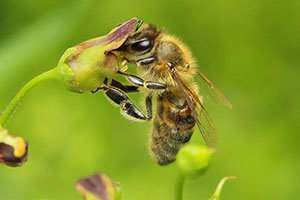
While humans were busy squabbling over the border between the United States and Mexico, a tiny black immigrant bee was discreetly homesteading in California. A new sighting of a Central American native bee, a member of the genus Plebeia, was recently reported in a genteel area of Palo Alto, some 500 miles to the north of Mexico.
Apparently, the manager of the Elizabeth Gamble Garden, an iconic public park, contacted a company for help in removing a bee nest from the premises. On seeing the nest, however, the exterminator sent a specimen to an entomologist who recognized the bee as Plebeia. Plebeia is one of many genera belonging to the tribe Meliponini, commonly known as the stingless honey bees.
Until this sighting, only one stingless bee colony was known to exist north of the Mexican border, a nest that was first discovered in a Palo Alto backyard in 2013 and was being monitored by the State of California. Plebeia is a small genus of heat-loving bees native to southern Mexico and Central America that ranges as far south as Argentina. Since the first sighting in California, at least three other photos of Plebeia have shown up on the citizen science site iNaturalist.org, all within a short distance of the original nest. These recent sightings are most likely descendants of the 2013 colony.
No one knows where they crossed the border or how they got so far north. Someone could have smuggled them in, or perhaps they hitched a ride in a shipment of goods. It is also possible, though highly unlikely, they traveled on their own over the course of many years. In any case, higher than average annual temperatures no doubt played a role in their survival.
From here and beyond
Here in North America, we tend to pigeonhole bees into two classes, honey bees and native bees. But that division is not accurate due to the many other non-native species that also live here. Lists have been assembled by various organizations, and depending on where you look and how you count, it is fairly easy to find the names of 45 to 70 bee species that have arrived on our shores since colonial times.
Based on the mathematics of reproduction, I suspect many more species have established populations we haven’t yet discovered. Like an invasive plant, a newly introduced bee species may increase by only a few individuals per year. Many years may pass before the population is large enough to spread. Often, by the time it is recognized as something unusual, the organism may have colonized a large area.
Terminology of Introductions
Species that move into new areas are known as adventive, but the word has several shades of meaning. Some scientists include deliberately introduced species, but others include only those that arrived on their own or by accident.
Some writers use adventive to describe species that are not self-sustaining, but need an occasional population boost from their homeland. If an adventive species becomes self-sustaining in its new geographic area, it is then said to be naturalized. Other words with variable meanings such as acclimatized, immigrant, and invasive make the subject even more confusing.
Stingless Bees are Not Alone
Whether the Palo Alto Plebeia bees will naturalize is unknown, but many bee species that arrive in North America are happy to call it home. The extreme example is the European honey bee, deliberately introduced into Jamestown, Virginia in the 1620s. Although it spread easily, the original population was supplemented frequently from its homeland until the Honey Bee Act of 1922 put a halt to additional imports in an effort to control the spread of diseases and parasites.
After that, little was added to the honey bee gene pool in the Americas until the accidental release of a small number of Apis mellifera scutellata occurred in Brazil in 1958. Those rogues immediately mated with the South American stock of Apis mellifera, giving rise to so-called Africanized honey bees. Although frequently called “scuts,” these bees are not pure A. m. scutellata, but a cross. Ironically, the cross appears to be more scrappy than the real thing.
The Africanized honey bee continues to spread farther and farther north aided by warmer temperatures, but also by shipping of queens and packages which likely contain genes from Africanized stock.
More Recent Interlopers
Another adventive bee from the south has settled in southern Florida and is a popular subject with photographers. Euglossa dilemma is a member of the orchid bee tribe, Euglossini. These bees, native to Central and South America, are a show-stopping iridescent green with tongues two-thirds as long as their bodies.
While the females have pollen baskets on their rear tibiae much like honey bees, the males have enlarged hollow tibiae with small openings in the side. Like bota bottles for bees, these containers are used to ….


